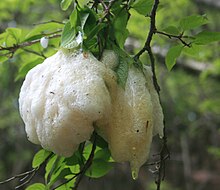| Rhacophorus | |
|---|---|

| |
| Malabar gliding frog (Rhacophorus malabaricus) Note the elongated toes with prominent webbing. | |
| Scientific classification | |
| Domain: | Eukaryota |
| Kingdom: | Animalia |
| Phylum: | Chordata |
| Class: | Amphibia |
| Order: | Anura |
| Family: | Rhacophoridae |
| Subfamily: | Rhacophorinae |
| Genus: | Rhacophorus Kuhl & Van Hasselt, 1822 |
| Species | |
|
See text | |
| Synonyms | |
| |
Rhacophorus is a genus of frogs in the shrub-frog family Rhacophoridae, which, with the related Hylidae, is one of the two genera of true tree frogs. They are found in China, India, Japan, and throughout Southeast Asia, including the island of Borneo. Over 40 species are currently recognised.[1]
These frogs have long toes with strong webbing between them, enabling the animals to strategically jump from tree to tree when threatened, using their webbing to gracefully “fall”, controlling their descent into a gliding motion. This is a form of arboreal locomotion known as parachuting.[2] This behavioral adaptation is the source of their common name, "flying frogs".
The present genus is closely related to Polypedates, which (formerly) was included in Rhacophorus. Even today, it is not fully agreed upon which of these genera "P." feae and the Chinese flying frog ("R." dennysi) properly belong to; furthermore, a supposedly new species, "P. pingbianensis", has been found to be the same as R. duboisi.

- ^ Frost, Darrel R. (2013). "Rhacophorus". Amphibian Species of the World 5.6, an Online Reference. American Museum of Natural History. Retrieved 15 April 2013.
- ^ John R. Hutchinson. "Gliding and Parachuting". www.ucmp.berkeley.edu. Regents of the University of California.